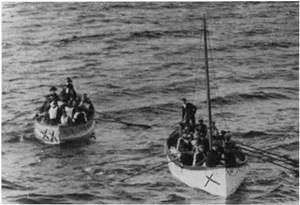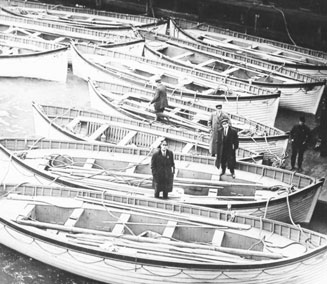Lifeboats on the Titanic
/One of the reasons so many individuals perished on the Titanic was the lack of enough lifeboats for everyone. Titanic had a maximum capacity of 3327, but on her one and only voyage, around 2224 passengers and crew were on board. However, her 20 lifeboats were capable of carrying 1178 at most. And because most of the boats left the ship less than full, only 712 survived the sinking.

Titanic lifeboats carrying survivors
Larger davits had been proposed for the new White Star Line ships, including Titanic, allowing for 48 lifeboats. But regulations issued by the Board of Trade required only 16 lifeboats for all British vessels over 10,000 tons. Titanic’s designers opted for 20 lifeboats, wanting to save on unnecessary costs and provide plenty of space for passengers to stroll the open decks. Twenty boats were more than the law required, and that seemed more than sufficient. After all, they could practically guarantee there would be no need for them.
Titanic carried 16 regular lifeboats, numbered 1 through 16. Eight even-numbered boats were mounted along her port side, and the eight odd-numbered boats along the starboard side. Four collapsible boats were stored near the bow, with two on either side.

Diagram showing lifeboat placement. Two collapsible boats (red) are not seen. The pink boats are emergency cutters.
Fourteen lifeboats each had a capacity of 65. They were 30 feet long, 9 feet wide, and 4 feet deep. They were supposed to be equipped with oars, blankets, provisions, and flares, although some survivors claimed their boats lacked one or more of these items. Two emergency cutters, boats 1 and 2, were built to hold 40. They measured 25 feet long and 7 feet wide. Their purpose was for immediate emergencies, such as a man overboard, and were permanently swung out, ready for lowering. The four collapsible boats, A, B, C, and D, were 27 feet long, 8 feet wide, and 3 feet deep. They had canvas sides that could be raised in use and could be stored almost flat.
A number of mistakes and misconceptions led to the boats leaving Titanic at less than capacity:
1) The one lifeboat drill had been cancelled due to cold weather.
2) When Captain Smith ordered passengers to be loaded into the lifeboats, many refused, not aware of the real danger. They felt it was safer to remain onboard the ship than climb into a small boat and be lowered to the sea. Many women didn’t want to leave their husbands, brothers, or sons.
3) Crewmen had not been given adequate lifeboat training. Some charged with filling the boats weren’t sure of how many the boats could hold and lowered them half-full.
4) Some crewmen strictly enforced the ‘women and children first’ rule, and when no more women and children were immediately available for boarding, they lowered the boats as the men watched.
5) Third class passengers reached the boat deck late, due to a lack of information and language barriers. Some were purposely kept back by crewmen until first and second class passengers filled the boats. By the time more third class passengers reached the boat deck and the true urgency of the situation was realized, most of the boats had already gone.

Lifeboats dropped at White Star Line pier in New York following arrival of the Carpathia, carrying 712 survivors
Only two lifeboats returned to the scene after the Titanic sank to rescue a few people in the water.
Following the inquiries into the sinking, a new ruling required every passenger vessel to be equipped with more than enough boats to carry every passenger and crewmember, and for crewmembers to be fully trained in lifeboat use. Also, lifeboat drills for all passengers on every voyage is now required by law.
Note: Beginning today, I will be posting on this blog every other Wednesday. As soon as my novel about Titanic survivor Ruth Becker is accepted for publication, I will share the news with you here. Thank you to all my readers! I look forward to bringing you more of the Titanic on April 13th, one day before the 104th anniversary of the sinking.
Photo credits: Historyofthetitanic.org, Titanicuniverse.com, Wikipedia
